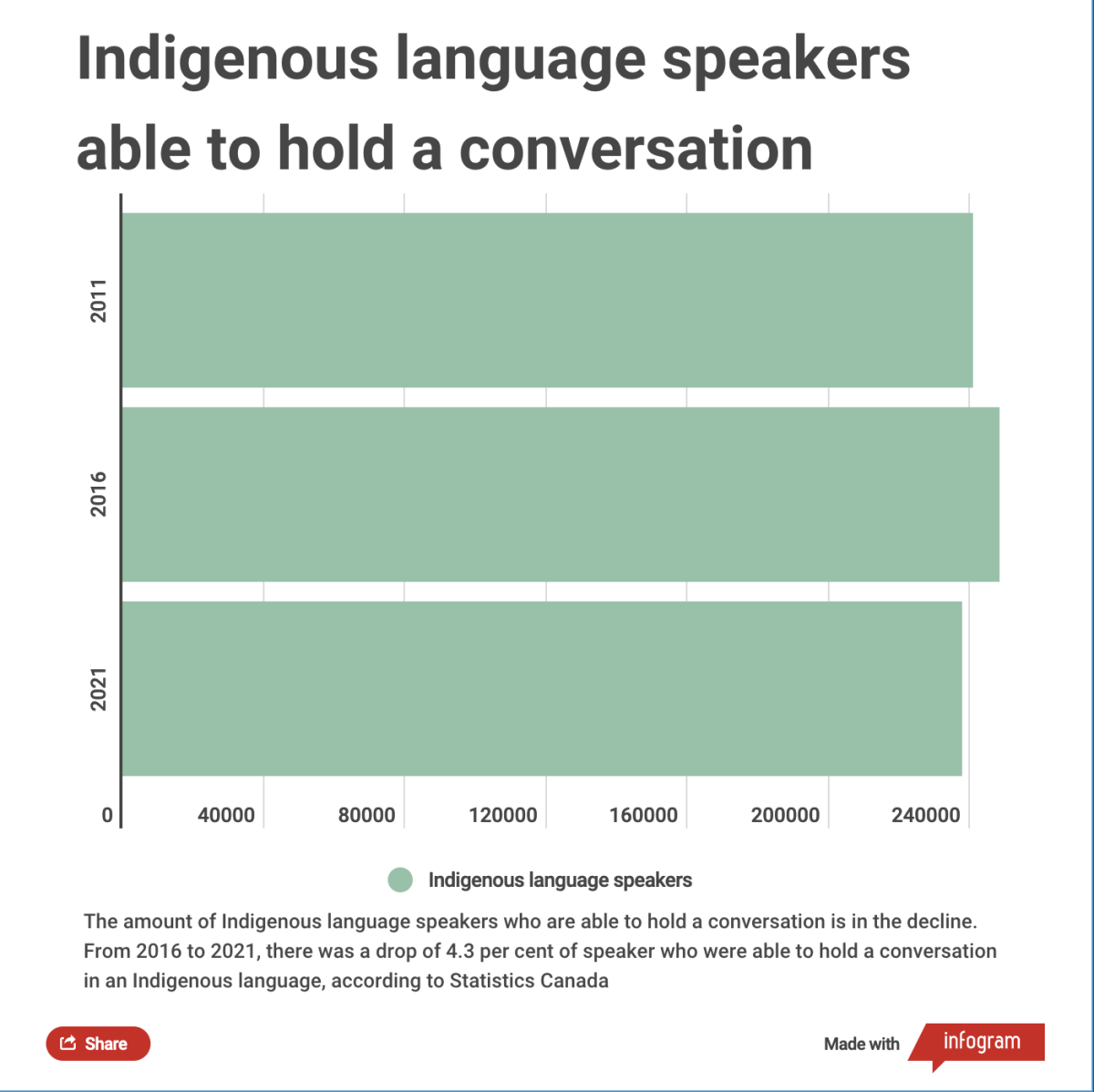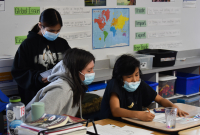Sol Mamakwa, Ontario NDP MPP for Kiiwetinoong, an electoral district spanning the northwestern edge of the province, stands in front of a room full of teachers, parents and students who were probably expecting a speech. He delivers, instead, a speak-through-the-soul conversation that moves between storytelling and political demands.
Mamakwa is a popular leader and something like a modern-day warrior. In March, he told the Matawa Education Conference, an annual training session for educators working in the 12 nations within the Matawa Tribal Council, that he sits directly across from Premier Doug Ford at Queen’s Park so he can “always try to stare him down, eh.” The room roared.
But it’s his critique of modern education, and its failings at engaging with ancestral traditions, that brings his fighting leadership forward.

“I think as First Nation Anishinaabeg, we cannot just learn … about who we are in the four walls,” Mamakwa said.
Throughout colonization, attending school has meant a loss of language, cultural practices and connection to the land. But what if school could also mean a return to the language, culture and territory that has been stripped away?
That is where land-based education — a catch-all term for traditions learned on the land, like how to clean an animal, prepare a hide or set a trap — can become a pivotal component of cultural and language teaching.
The benefits of land-based programming include enhanced resilience, improved physical and mental health outcomes and improved educational outcomes, among others, said Mandee McDonald, a PhD candidate at the University of Alberta and a land-based workshop facilitator.
“Indigenous-led programs, preferably on our lands, connect youth to their identity, community mentors, land, waters, cultural stories, traditional knowledge and language,” reads a study quoted by McDonald in her paper called Indigenous Land-Based Education in Theory and Practice, which was published by the Yellowhead Institute.
However, challenges still need to be addressed regarding sustainable staff hires and professional requirements. It often boils down to who is considered a language teacher, particularly when it comes to elders, in an education system that currently requires professional certifications to teach an Indigenous language.
Chapter 1: Language and the land
Mamakwa is an Indian day school survivor who attended school in Kingfisher Lake First Nation. As it was for all survivors, the institution the Crown mandated he attend was an assimilating force. English is his second language. He learned his language, Oji-Cree, on the ancestral land of his people during the spring hunt.
Mamakwa told his story in the bright, log-panelled lobby of the Val Halla Hotel, a five-minute drive from the Thunder Bay airport. In the hotel conference rooms nearby, Day 2 of the Matawa Education Conference was underway and teachers were in a professional development session on how best to serve First Nation youth from the 12 First Nations that Matawa represents.
Mamakwa’s eyes flitted across the lobby floor as we talked. He described how First Nations’ pedagogy was displaced by colonization, traded for classroom and western teaching methods. The education system removed students like him from the land for most of the year. And in some areas of Ontario, it continues to do so, despite some gains and funding for land-based programming.
He pauses the interview often. Old friends and constituents walk by, headed towards the lobby’s elevator. It’s an opportunity to speak and joke in his language.
Mamakwa thinks Indian day schools, or even the high schools of today, prioritize formal western education over First Nation pedagogy.
For example, Mamakwa tells a story about his time as an education director in his First Nation, Kingfisher Lake, where he helped develop an immersion program that taught exclusively in Oji-Cree until Grade 3.

When he told the story during his keynote, he didn’t mention the trepidation parents had about putting their children in an immersion program.
“Younger parents were worried about their children, that they could not understand English at the younger ages,” Mamakwa said.
It’s part of the balancing act Indigenous parents go through: do they teach their children ancestral values, or ready their youth for a Canada that prioritizes formal education in classrooms over how to live with the land?
“It became an issue of, ‘English is more important than our own language,’ and that is concerning,” Mamakwa said.
By high school, students leaving Kingfisher Lake were three or four years behind in literacy and numeracy.
It’s unclear if the immersion program was to blame. There were other factors at play, such as teacher shortages, high staff turnover, long-term underfunding of First Nation schools and systemic inequities arising from residential schools and exploitive resource development.
Still, the former lieutenant-governor, James Bartleman, brought in English literacy camps for students. Mamakwa wasn’t in politics yet, but the situation charged him: “It was backwards; English was more important than our own language.”
In Canada, Indigenous languages are steadily declining, census numbers from 2016 to 2021 show. During that time, the number of Indigenous language speakers who could converse dropped by 10,750, or 4.3 per cent. Most new speakers of Indigenous languages are second language learners, demonstrating a drop in what is spoken in households within Indigenous communities.
Mamakwa believes the equation needs to flip. He envisions students learning their language and land-based practices in the spring hunt, learning Indigenous language as literacy and counting geese as a form of numeracy. The only problem is it’s not so easy to measure success: there is no standardized testing for survival and hunting skills.
And yet, all First Nation youth are forced to walk in two worlds. If Indigenous students prioritize English to meet job market demands, they risk losing a sense of identity and deeper connections to their elders. If they sacrifice a formal education, they can lose out on higher salaries and other opportunities in mainstream Canada.

Cassandra Spade, 28, is a young Anishinaabe language learner. She didn’t learn her language until her mid-20s. At first, she studied French in public school. Then, in university, she took up German on an exchange program.
“I had the same idea that a European language was a language that would bring me a better job; I would have more opportunities,” she said.
But when she finished her undergraduate degree, something was missing, something big. Her identity was obscured. And like a smudged mirror, she couldn’t see herself in the languages she was learning, couldn’t articulate who she was.
The missing piece became clear when she left to study Anishinaabemowin in an immersion program. One program led to another, and within a few years, she was able to start communicating in Anishinaabemowin with her great-grandmother, who can’t speak English.
By learning her language, Spade literally connected with her ancestors and herself.
Chapter 2: Immersion and land-based learning
Spade is an emerging Indigenous leader. She’s in her first year in law school and has been mentored by Indigenous leaders like Mamakwa and Phil Fontaine, a former national chief at the Assembly of First Nations, since she was a young adult.
But it’s through her community work with Gaa-Minwaajindizowaaj, a grassroots organization Spade and her family created to foster culture and language revitalization, that her leadership shines.
The organization will be invited into a community in the North, where it will teach lessons through worksheets, games and essential survival language. For example, a sewing or bookmaking project will be conducted exclusively in Anishinaabemowin.
“The main focus is that we prioritize your language, and so we're always trying to use language in everything that we do,” she said.
Spade developed her teaching skills working with a kindergarten class at an Anishinaabe immersion program in the northern United States. The school operates in sync with seasons: in the fall, kids learn about the wild rice harvest, winter is designated for winter storytelling and legends, and come spring, students are taken to the sugar bush to make maple syrup.
The program is entirely in Anishinaabemowin, testing and honing Spade’s handle on her language, a particularly difficult task when reining in a group of four- and five-year-olds. But it’s worth it, given the cultural teachings embedded in Anishinaabe culture, language and land, she said. Spade tells a story of a springtime lesson in the bush when students began ripping off branches to throw around and play with, as if the tree was another plastic toy.
“I started explaining to them that [the trees] are giving us sap, and they're feeding us, they're taking care of us, and when something takes care of us, we have to return that back.”

After Spade explained the reciprocity inherent in Anishinaabe land practices, students began to notice the knots in the trees, recognizing them as eyes.
The kids began a game of tag. “In that moment … they started to play with the trees, instead of using the trees to play with,” Spade said.
Language is also a focus at Cat Lake First Nation, located 400 kilometres north of Thunder Bay. A dedicated language educator teaches students Anishinaabe using cue cards that focus on vocabulary, among other lessons. The community also has an app to help students learn with help from fluent community members reading the flashcards.
But even in a small community like Cat Lake, challenges pop up when the lone qualified Anishinaabe teacher is on leave, causing the school’s kindergarten teacher, Sylvia Wesley, to sub in the best she can. It’s one of the reasons why the community’s app is important in bringing students to their language.
Chapter 3: Certifications as a barrier to teaching language
Despite all of Spade’s experience, she is not permitted to teach in northern Ontario First Nation schools because she doesn’t have the required paperwork.
It’s a significant barrier from a teacher’s perspective, Spade said. Even fluent community members often need a bachelor of education and native language teacher certification to teach Anishinaabe or Oji-Cree in their First Nation schools.
To get the necessary credentials, teachers must leave their communities and move to the city, where other opportunities and jobs present themselves, perhaps with better pay and access to services.
As well, “intergenerational learning,” the form of education Spade learned at her Anishinaabe immersion program, is absent in Canadian schools, she said. In the U.S., Spade worked with a senior teacher and elder in the same classes. It created a system of direct mentorship, community engagement and knowledge sharing with the community’s knowledge keepers.
And without a grounded, land-based program, teaching Anishinaabemowin becomes another part of the formal education marked by colonial second-language teaching methods.
“I talk about the land because that’s where the elders spoke about it, that’s where the education is, that’s where the teachings are, that’s where the healing is,” Mamakwa added. “We need the land and the land needs us.”







Comments